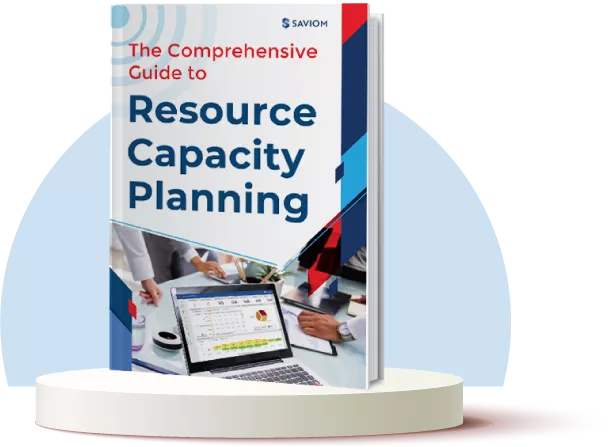In projects with strict deadlines, there is immense pressure on the project manager to achieve milestones without overloading team members. This is where resource smoothing makes a difference. By strategically distributing work within available time constraints or bringing in additional resources when needed, managers can achieve successful project outcomes without overburdening the team.
This technique allows managers to adjust float tasks and ensure a steady project workflow. Thus, it helps avoid peaks and troughs in resource utilization. When applied correctly, resource smoothing allows organizations to maximize operational efficiency while maintaining a balanced and productive work environment.
In this blog, we will delve into the fundamentals of resource smoothing and outline key steps to apply to projects.
But first, let’s begin with the basics.
What is Resource Smoothing?
Resource smoothing, or time-constrained scheduling (TCS), is an optimization technique that ensures efficient resource allocation without altering the project deadline. It involves adjusting the project schedule within the available slack time, redistributing tasks, or pulling in additional resources while maintaining the overall timeline. The goal is to ensure balanced resource utilization, enhance operational efficiency, and ensure timely project completion.
When Should It Be Applied?
Resource smoothing is applied to time-sensitive projects with fixed start and end dates. It ensures tasks are completed within the set timeline by redistributing workloads within Slack or bringing in additional personnel when needed. This prevents resource overallocation, maintains steady progress, and keeps non-critical tasks from affecting the project schedule.
Now that we understand when to apply resource smoothing let’s explore it further with an example.
Resource Smoothing Example
A software company is developing a mobile banking app with an 8-month deadline covering UI/UX design, backend development, security testing, and final deployment. Midway through the project, the manager realizes that some tasks are overloading certain engineers while others have idle time.
To prevent workload imbalances, the manager applies resource smoothing by adjusting non-critical task assignments within available slack time. This allows engineers to focus on high-priority features without exceeding the fixed deadline or overburdening resources. This prevents bottlenecks, avoids unnecessary delays, and keeps the project on track.
Now, let’s explore the differences between resource smoothing and resource-leveling.
Read More: What is Resource Optimization? A Complete Guide to Improve Project Delivery
Resource Smoothing vs. Resource Leveling: Key Differences
We have already learned the definition of resource smoothing, but to draw a clear comparison, let’s first understand resource-leveling.
Resource leveling is a project management technique that adjusts project dates to align tasks with available resources. When resource constraints make it impossible to complete tasks as initially scheduled, the timeline is extended to prevent overallocation and ensure efficient resource utilization.
The table below shows the key differences between them:
| Aspect | Resource Leveling | Resource Smoothing |
|---|---|---|
| Definition | Resource leveling is a technique that reschedules project dates to align with resource availability, ensuring efficient resource utilization. | A technique that redistributes tasks within available slack time or deploys extra resources to balance utilization levels while keeping the project deadline unchanged. |
| Primary Constraint | Limited resource availability | Fixed project timeline |
| Impact on Critical Path | May extend the critical path if tasks require additional time | It does not change the critical path; adjustments occur within available Slack. |
| Project End Date | May shift due to resource constraints | Remains constant |
| Key Use Case | Managing overallocated resources by adjusting timelines | Ensuring steady workload distribution without overburdening resources |
| Task Rescheduling | Tasks can be delayed beyond original timelines to accommodate available resources | Tasks are adjusted within available slack to maintain workflow balance |
Now, let’s explore the benefits of resource smoothing.
The Advantages of Resource Smoothing
Resource smoothing helps maintain a balanced workload while ensuring timely project completion without exceeding the deadline. Here are a few advantages of resource smoothing:
Maintains the Integrity of the Critical Path
The critical path method maps the longest sequence of dependent tasks that dictate a project’s timeline. It is shaped by key factors like task estimations, dependencies, project milestones, etc. Resource smoothing ensures that the critical path is intact by optimizing workload distribution within available slack or mobilizing additional resources if needed. This prevents over-allocation while ensuring the project stays on schedule.
Helps Address Resource Demand Fluctuations
Changing client requirements or shifting priorities can lead to a ramp-up in resource demand. In these situations, project managers can leverage resource smoothing to bring in additional resources without disrupting the project timeline. This approach helps optimize the workload of existing resources, ensuring optimal workforce utilization and maintaining efficiency, even during periods of peak demand.
Read More: What is Demand Planning & Why is it Important for Businesses?
Promotes Even Workload Distribution
The resource smoothing technique balances workloads and prevents peaks and troughs in resource utilization. This balanced distribution minimizes stress, enhances productivity, and fosters a more sustainable work environment. Ultimately, it leads to improved team performance and successful project outcomes.
Enhances Employee Engagement & Morale
Maintaining a balanced workload prevents burnout and reduces stress, allowing employees to stay focused and perform at their best. When resources are allocated efficiently, team members feel supported and valued, fostering a positive work environment. This enhances employee engagement, boosts morale, and strengthens overall job satisfaction.
Read More: 11 Effective Strategies to Enhance Employee Engagement
Facilitates Timely Delivery of Projects
For time-sensitive projects, resource smoothing enables the redistribution of tasks within available slack or bringing in additional support to prevent workload imbalances. It allows project managers to adjust resources as needed, maintaining a steady workflow and minimizing delays. This helps optimize resource utilization, enhance team efficiency, and ensure delivery within the set timeline.
We will now move on to read the drawbacks of resource smoothing.
The Drawbacks of Resource Smoothing
Though resource smoothing can improve workforce optimization, it also has some downsides. Here are a few.
Reduces Adaptability of the Project
Resource smoothing reduces flexibility by keeping the project’s end date fixed, leaving little room for adjustments. With limited slack time, handling unexpected changes, urgent requests, or shifting priorities becomes difficult. This can create bottlenecks, making it harder to manage delays without disrupting workflows.
Leads to Resource Scheduling Conflicts
In multi-project environments, resource smoothing adjusts tasks within available slack to optimize resource utilization. However, when shared resources are assigned to multiple projects, aligning their availability with task schedules becomes challenging. This misalignment can lead to scheduling conflicts, reduced productivity, and potential project delays.
Read More: What is Resource Scheduling? How to Schedule Resources for Projects Efficiently?
Elevates Stress Levels of Team Members
When workloads are redistributed to fit within a fixed timeline, employees deal with tighter schedules and increased pressure to meet deadlines. Consequently, limited flexibility or sufficient downtime can lead to burnout, decreased morale, and sub-optimal productivity. Over time, this heightened stress may impact employee engagement and job satisfaction.
Increases Project Resourcing Costs
Resource smoothing is applied when project deadlines are strict and cannot be altered. If managers observe that resources are overutilized, they bring in additional resources to balance the workload, which leads to an increased overall budget. Additionally, when managers assign first-available, best-fit resources to tasks, it can result in skill mismatches and subpar deliverables, further escalating resource costs.
Now, let us see how to implement resource smoothing in a project in detail.
Resource Smoothing Steps
Resource smoothing ensures that workloads are balanced while keeping the project on schedule. Here’s how it’s done:
Create the Project Schedule
To begin with, define all project tasks, their dependencies, and estimated durations. Use project management tools like Gantt charts or work breakdown structures to visualize task sequences. Ensure each task has a clear start and end date to maintain a structured timeline.
This foundation helps organize workflows and set realistic deadlines. Once the schedule is outlined, incorporate buffer time for unforeseen delays while maintaining fixed project deadlines. The schedule should align with overall project goals, ensuring smooth execution.
Read More: What is Project Scheduling: Examples, Benefits, and Best Practices
Identify the Critical Path
Secondly, determine the sequence of tasks that directly impact project completion. The critical path consists of tasks that have zero slack, i.e., delaying them would push back the entire project. Therefore, identifying these ensures that critical activities are prioritized and remain on track.
For example, in a construction project, laying the foundation must be completed before structural work begins. Prioritizing resources for foundation work ensures subsequent tasks stay on schedule, while non-critical tasks like landscaping can be adjusted without affecting deadlines.

SAVIOM’s Gantt Chart helps project managers identify critical tasks that must be completed as planned to keep the project on track.
Assess Float Task or Slack Time
The next step is identifying float or slack, which helps determine which tasks can be delayed without affecting the project’s final deadline. This allows project managers to manage or adjust schedules strategically to ensure critical tasks remain on track.
Further, when resources are overutilized, managers can leverage float time to redistribute workloads, prevent burnout, and maintain productivity. This approach ensures balanced workloads and smooth project execution without exceeding the fixed timeline.
Assign Tasks Based on Resource Availability
Once the float tasks are identified, managers can assign suitable resources by considering factors such as employee holidays, work shifts, and existing commitments. This ensures that resources are present to take on workloads while preventing scheduling conflicts.
This helps optimize resource utilization, enhances productivity, and ensures smooth project execution. For example, if a production supervisor is scheduled for night shifts, assigning them a daytime task may lead to fatigue and inefficiency. Instead, managers can allocate the task to a team member who is available during the day for seamless operations.
Read More: What is Resource Availability in Project Management, and Why Does It Matter?
Use Slack Time to Optimize Allocations
In this step, project managers can use the slack time to address less urgent tasks and prevent excessive resource strain. It enables them to reassign resources to high-priority tasks that require immediate attention without overloading them. Thus, it helps balance workloads and avoid extension of project deadlines.
Additionally, slack time can be used to tackle unforeseen challenges, such as resource unavailability, task spillover, or ad-hoc changes. This buffer allows for efficient task execution by freeing up time for other critical work, keeping the project moving smoothly, and ensuring a better resource health index.
Monitor Resource Utilization Consistently
For resource smoothing to be effective, managers must continuously monitor workforce utilization levels throughout the project’s execution. This involves tracking workloads in real time to identify any signs of resource overutilization or under-allocation and make informed decisions.
For instance, if the resource utilization rates indicate workload imbalances, managers can readjust non-critical tasks or allocate additional personnel to prevent overloading. This ensures optimal resource utilization, enhances overall efficiency, and boosts employee productivity levels without affecting the critical path.
Read More: How to Track Resource Utilization?
Refine the Schedule as Needed
Finally, even after balancing workloads, unforeseen changes like shifting priorities or sudden resource unavailability may arise. Managers must periodically review the schedule to identify workload imbalances and refine task allocations, ensuring steady execution without disrupting critical deadlines.
For instance, when workload imbalances occur, managers can assess and adjust resource allocations to maintain operational efficiency. This proactive approach prevents disruptions, boosts productivity, and keeps the project aligned with its fixed timeline.
Lastly, let’s understand how robust resource management software can help with resource smoothing.
How Can Resource Management Software Help?
Advanced resource management software helps project managers to optimize workforce allocation and implement resource smoothing when appropriate. Let’s explore how it works:
- The tool offers enterprise-wide visibility into the talent pool. This allows managers to identify and allocate available resources that match project requirements.
- Its multi-dimensional scheduler helps managers adjust workloads dynamically with easy drag-and-drop action, preventing overutilization and scheduling conflicts.
- The color-coded heatmaps and utilization reports provide real-time insights into resource usage, allowing team leads to identify overloaded employees and balance work distribution accordingly.
- Finally, the what-if analysis feature allows scenario-based planning to optimize resource distribution. By simulating different scenarios, organizations can create the best-fit project resource plan and address any constraints effectively.
Read More: How Can You Make Data-Driven Decisions with Resource Management Software?
Conclusion
Effective resource smoothing enhances employee productivity and ensures optimal performance. By following the outlined steps and utilizing advanced resource management software, businesses can balance workloads efficiently, prevent burnout, and maximize profitability while maintaining seamless project execution.
So, are you ready to leverage resource smoothing to keep your projects running smoothly?
The Glossary
Read More: Glossary of Resource Workforce Planning, Scheduling and Management










